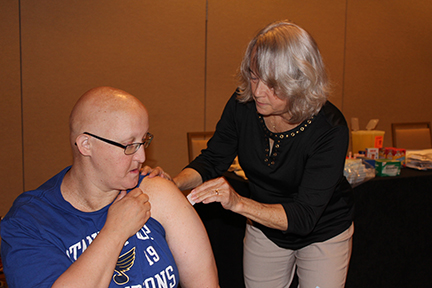While a clinical diagnosis for ectodermal dysplasia is helpful in treating and understanding your condition, it’s also subjective. In many cases, genetic testing can help to confirm your doctor’s suspicions by looking for changes in your genes that cause medical issues like ectodermal dysplasias.
We’ve covered some frequently asked questions that we hear about genetic testing to help you understand the process and how it’s used for those affected by ectodermal dysplasias.

What is genetic testing?
Our genetic information (i.e. our genes) determines how our bodies look and function. Our genes are composed of DNA and are organized into structures called chromosomes. We have over 20,000 genes which are in every cell of our body and serve different functions. Genetic testing looks at our genes and/or chromosomes to see if we can find any changes that may explain someone’s features.


How are genetic tests performed?
Common samples used for genetic testing include blood, saliva, buccal (cheek) swab, or skin biopsy. The testing laboratory looks at DNA from these samples and compares it to a database of genetic information. They are looking for any changes (called “variants”) in genes that may explain your symptoms.

What are the different types of genetic tests?
There are multiple types of genetic tests that are designed to detect different types of genetic changes. Each test has benefits and limitations.
The following types of genetic testing are commonly used to diagnose ectodermal dysplasias.
Single gene testing
If there is high suspicion that a change in one specific gene is causing you or your child’s symptoms, then single gene testing may be considered. This kind of test involves reading every letter of the gene to look for misspellings, missing letters, or extra letters in the DNA code. Once a change is identified in a family, this test can also be used to test relatives for the known genetic change in the family.
Targeted gene panel testing
This kind of test looks for changes in many different genes that are known to cause ectodermal dysplasia. Every genetic testing laboratory chooses its own list of genes to include on a targeted panel, therefore careful review of the panel is important to make sure that it includes the gene(s) that the provider is most concerned about.
Exome sequencing
This test looks at all the exons, or the parts of genes that code for proteins. The exome accounts for about 1-2% of our DNA, but about 85% of the changes that are associated with genetic conditions.
For exome sequencing, typically the affected individual and both parents would provide a DNA sample. This allows the laboratory to compare the parents’ DNA to the affected person’s DNA. The laboratory also filters the genetic information based on what clinical features you or your child has and only looks at genes that may cause those symptoms. However, you may choose to receive information about genetic changes that cause other conditions unrelated to you or your child’s symptoms, too.
This test may find a genetic answer for your ectodermal dysplasia syndrome. It is also possible to find a result in a gene that is not well-understood, or that may explain only part of your or your child’s symptoms.
This data can be re-analyzed over time as we learn more about genetics. Please speak with a genetic counselor or other genetics professional if you are interested in exome sequencing to discuss the benefits and limitations of this test.
Genome Sequencing
Genome sequencing looks at all of the genetic information to find an explanation for your symptoms. This is the most comprehensive genetic test available, although it is still not perfect. The data from this test can be re-analyzed over time as we learn more about genetics.
Please speak with a genetic counselor or other genetics professional if you are interested in whole genome sequencing to discuss the benefits and limitations of this test, and to tailor the findings to your preference.

What can a genetic test result tell me?
There are three types of results you may receive on your genetic test report: positive, negative, and variant of uncertain significance (VUS).
Positive
Diagnosis: A positive genetic test means that the lab identified a change in a gene that has been associated with a genetic condition.
This usually confirms the diagnosis of ectodermal dysplasia. It may also tell us which subtype of ectodermal dysplasia you or your child has. This can give us more information about what to expect and look out for over time. It may be helpful for your or your child’s healthcare providers to know. This information may also be helpful if you are interested in enrolling in research studies or clinical trials.
Inheritance: Genetic testing can also tell us about how this condition is passed on in families, and whether other family members may benefit from testing. The genetic change may be de novo, meaning it happened for the first time in you or your child, or it may have been inherited from one or both parents. Depending on the inheritance pattern (autosomal dominant, autosomal recessive or X-linked), there will be varying risks of recurrence in future children and other family members.
Negative
This means that no changes (or variants) were found in the genes related to ectodermal dysplasias. This rules out many of the known genes and changes associated with ectodermal dysplasia, but a negative test result does NOT mean that you or your child does not have this condition. It is possible that the type of testing that was done did not detect the genetic change, in which case you may choose to pursue more comprehensive testing.
There is so much still unknown about genetics, and you or your child may have a change in a gene that has not been discovered yet. You may choose to get updated testing or re-analysis of previous testing in the future.
Variant of Uncertain Significance (VUS)
This means there was a genetic change found on the test, but there is not enough information at this time to know if it causes a condition like ectodermal dysplasia or if it is a benign change that does not cause any problems. Oftentimes, testing other family members may help interpret the significance of these variants.
It is possible that over time, a VUS result may be reclassified as benign, meaning it does not affect gene function and is not clinically significant or pathogenic, meaning that there is now evidence that it is clinically significant. A VUS result is NOT a diagnosis and should not be used to change medical management.
Who orders a genetic test? Do I have to see a doctor to get one?
Physicians and other health care providers can order genetic tests. Many patients meet with a provider who has special training in genetics, such as a medical geneticist or genetic counselor, before getting genetic testing. It is possible to initiate genetic testing without seeing a provider first, however, the interpretation of genetic test results can be complex, so it is best handled by genetics providers who are specially trained in the interpretation and understanding of genetic test results.
What happens at a genetic visit to know what type of test to order?
At a genetics visit, you may meet with a geneticist and genetic counselor. They will review your medical history, perform a physical evaluation, and ask questions about your family history. They will use this information to help decide what kind of genetic testing would be the most appropriate for you, if any.
They will explain how the test works, what it looks for, and benefits and limitations of the testing offered. They will answer any questions you may have to help you make a decision. If you choose to pursue testing, they will coordinate obtaining a DNA sample and begin the process. Sometimes, insurance companies will require pre-authorization first, so testing may be delayed until insurance approval is received.
I know I have ectodermal dysplasia, so why do I need genetic testing?
Genetic testing is optional. Each individual has the right to make a decision about testing based on what is best for themselves and their family. The information you can get from a genetic test depends on the kind of test that was done and the result.
Benefits of a Genetic Diagnosis
- There are other conditions whose symptoms overlap with those of ectodermal dysplasia that may be discovered through testing.
- There are over 100 subtypes of ectodermal dysplasia caused by many different genetic changes. Genetic testing can confirm a diagnosis of a subtype of ectodermal dysplasia.
- It can provide more information about what to be aware of for your medical management.
- A genetic diagnosis may help you access services and research trials.
- Testing can provide answers about how and why the condition happened, as well as the chances of future children being affected.
- A positive genetic test result can be informative for your family members, too, and can be used to help them get genetic testing.

Would everyone in my family need to be tested?
Genetic testing is the most informative for people who are affected by a condition. We recommend starting by testing someone who has symptoms. If a genetic change is found on their test, then we would test other family members to see if they have that change as well. Testing the affected individual’s parents can be helpful to determine if the change was inherited or happened for the first time in that individual.
How do online services compare with seeing a physician or geneticist?
There are now online services to get a genetic test. These online services are CLIA-certified laboratories, meaning they meet federal standards for diagnostic genetic testing of human samples. This is especially important for clinical testing where the results may be used for diagnosis and management.
For example with Invitae, you can initiate a genetic test on your own, but an independent physician will need to approve the order after reviewing it along with your medical history. If you are not sure what kind of genetic testing (if any) would be most appropriate for you, then speaking with a genetics professional first is recommended.
What is the range of costs for tests? Will my insurance cover it?
The cost and insurance coverage depends on factors like the type of genetic test, the testing laboratory, and your insurance plan. The cost may range from less than $100 to thousands of dollars; health insurance may cover at least part of this expense in many circumstances. Over time, we expect that genetic testing will become more affordable.
Should I be concerned about genetic discrimination and confidentiality?
The Genetic Information Nondiscrimination Act (GINA) ensures that people cannot be discriminated against for health insurance based on a genetic testing result. Unfortunately, there are not nationwide protections in place for disability, life, and long-term care insurance. Additional protections vary by state. If someone is experiencing symptoms already, then it is unlikely that the genetic test result will affect their insurance premiums. However, this is something to consider for people who do not have clinical symptoms.
Clinical genetic testing is considered protected health information under the Health Insurance Portability and Accountability Act (HIPAA). Like other medical test results, genetic testing would be noted in your medical record. Please note that unlike other medical tests, your genetic test result may have implications for the health of your family members.
Genetic testing laboratories may de-identify your genetic data and use it to conduct research. Many laboratories allow you to opt out from this; please speak with your genetics provider if you have concerns.
There are many benefits to genetic testing for individuals and families affected by ectodermal dysplasias. If you think it could be helpful for you or a loved one, meet with your physician to discuss your options, the types of testing they’d recommend, and other considerations you may need to weigh.